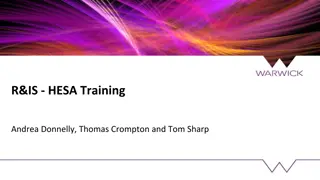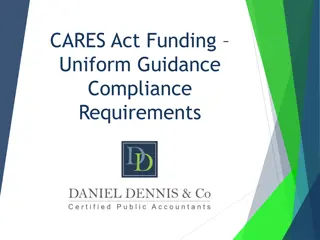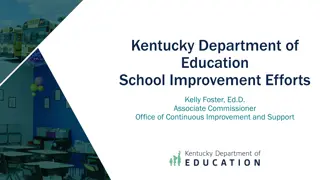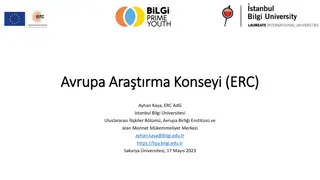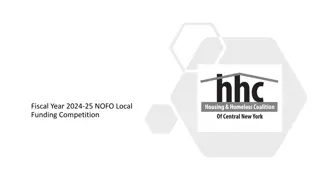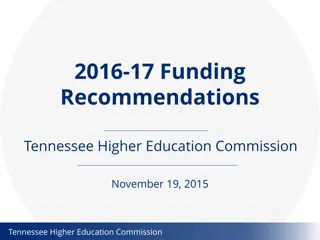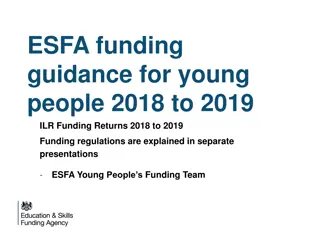Funding Requirements for Higher Education Improvement Projects
The content outlines the restrictions and regulations related to the release of capital funds for planning and improvement of higher education facilities from the Higher Education Improvement Fund. It highlights conditions under which funds may be released, including ownership or long-term lease agreements of real property, joint use agreements with nonprofit organizations or public bodies, and administrative cost reimbursements. The Department of Higher Education is responsible for adopting and maintaining rules for capital facility appropriations in state-supported institutions.
Download Presentation

Please find below an Image/Link to download the presentation.
The content on the website is provided AS IS for your information and personal use only. It may not be sold, licensed, or shared on other websites without obtaining consent from the author. Download presentation by click this link. If you encounter any issues during the download, it is possible that the publisher has removed the file from their server.
E N D
Presentation Transcript
Higher Education Improvement Fund Joint Use Agreements
Capital Appropriations Bill HB 687 SECTION 207.43. (A) No capital appropriations in this act made from the Higher Education Improvement Fund (Fund 7034) or the Higher Education Improvement Taxable Fund (Fund 7024) shall be released for planning or for improvement, renovation, construction, or acquisition of capital facilities if the institution of higher education or the state does not own the real property on which the capital facilities are or will be located. This restriction does not apply in any of the following circumstances: (1) The institution has a long-term (at least twenty years) lease of, or other interest (such as an easement) in, the real property. (2) The Department of Higher Education certifies to the Controlling Board that undue delay will occur if planning does not proceed while the property or property interest acquisition process continues. In this case, funds may be released upon approval of the Controlling Board to pay for planning through the development of schematic drawings only. (3) In the case of an appropriation for capital facilities that, because of their unique nature or location, will be owned or will be part of facilities owned by a separate nonprofit organization or public body and will be made available to the institution of higher education for its use or benefit, the nonprofit organization or public body either owns or has a long-term (at least twenty years) lease of the real property or other capital facility to be improved, renovated, constructed, or acquired and has entered into a joint or cooperative use agreement with the institution of higher education that meets the requirements of division (C) of this section.
(C) The Department of Higher Education shall adopt and maintain rules regarding the release of moneys from all the appropriations for capital facilities for all state-supported or state-assisted institutions of higher education. In the case of capital facilities referred to in division (A)(3) of this section, the joint or cooperative use agreements shall include, as a minimum, provisions that: (1) Specify the extent and nature of that joint or cooperative use, extending for not fewer than twenty years, with the value of such use or benefit or right to use to be, as is determined by the parties and approved by the Department of Higher Education, reasonably related to the amount of the appropriations; (2) Provide for pro rata reimbursement to the state should the arrangement for joint or cooperative use be terminated prior to the expiration of its full term; (3) Provide that procedures to be followed during the capital improvement process will comply with appropriate applicable state statutes and rules, including the provisions of this act; and (4) Provide for payment or reimbursement to the institution of its administrative costs incurred as a result of the facilities project, not to exceed 1.5 per cent of the appropriated amount.
Ohio Administrative Code Rule 3333-1-03 (E) Capital projects - facilities not owned by state or institution Prior to recommending release of capital funds to institutions for facilities which, because of their unique nature or location, will be owned or will be part of facilities owned by a separate nonprofit organization or public body, the institution shall submit and the chancellor shall approve a joint use agreement which shall include provisions that: (1) Specify the extent and nature of the space to which the institution is to be granted rights for use in its educational programs and the terms and conditions governing such use. (2) Specify that the term of the agreement shall be for at least twenty years. (3) Provide for reimbursement to the state should the institution's right to use the facility be terminated by the nonprofit organization or public body prior to the expiration of the twenty-year term, which reimbursement shall be calculated by dividing the funds contributed by the state of Ohio by twenty and multiplying that sum by twenty less the number of full years the facility is utilized by the institution. (4) Provide that the nonprofit organization or public body comply with all pertinent federal, state and local laws as well as state administrative regulations. (5) Specify that funds shall be used only for capital improvements as defined in the bill appropriating such funds. (6) Identify the facility to be constructed, renovated or improved. (7) Identify the ownership of the facility or the basic terms of the leasehold by the nonprofit corporation or public body. (8) Specify that the nonprofit corporation or public body shall hold the institution harmless from all liability for the construction, operation and maintenance costs of the facility. (9) Require the nonprofit corporation or public body to follow competitive bidding procedures which include, as a minimum, publishing advertisements to seek bids, receiving sealed bids, and awarding contracts to the lowest responsive and responsible bidders. (10) Provide for reimbursement to the institution for administrative costs incurred as a result of the project, which sum shall equal one and one-half per cent of the appropriated amount. (11) Provide that amendments to the agreement shall require approval by the chancellor of higher education.
HB 687 SECTION 209.10. ETC BROADCAST EDUCATIONAL MEDIA COMMISSION Higher Education Improvement Fund (Fund 7034) C37406 Network Operations Center Upgrades $1,097,110 C37410 Ohio Radio Reading Services $26,726 C37424 Television and Radio Equipment Replacement - Emergency Communications $2,091,583 C37425 New WYSO Headquarters $300,000 TOTAL Higher Education Improvement Fund $3,515,419 TOTAL ALL FUNDS $3,515,419
ODHE Checklist 1 1 Is the facility to be built/improved identified specifically by address or location? Does the non-profit organization now own the property or have a long term lease? If not, when will it control the property? 1 2 Does the agreement provide for use of the facility for at least 20 years from the time that it is ready for occupancy? 2 3 If the agreement is terminated, is there a pro rata reimbursement clause? Is the reimbursement formula correct? 3 4 4 5 Will funds be used only for capital improvements and not operating costs? Will the non-profit hold the institution harmless for all construction, operation, and maintenance costs? 5 6 6 7 Will the non-profit comply with federal, state, and local laws and rules? 7 Is the non-profit required to competitively bid as outlined generally in ORC Chapter 153 (published ads, sealed bids, public opening, award to lowest responsive and responsible bidder, etc.)? 8 8 9 Does the contract provide for a 1.5% administrative fee for the institution? $11.250 9 10 Does the agreement require that amendments be approved by the Department of Higher Education? 10 11 Is a drawdown schedule or payment procedure included? P 12 Are the extent and nature of spaces and uses adequately described? P 13 Are the terms and conditions of use of the facility described? Has the institution demonstrated that the value of the use of the facility is reasonably related to the amount of the appropriation? (See attached worksheet) P 14 5 15 Is the facility insured?





